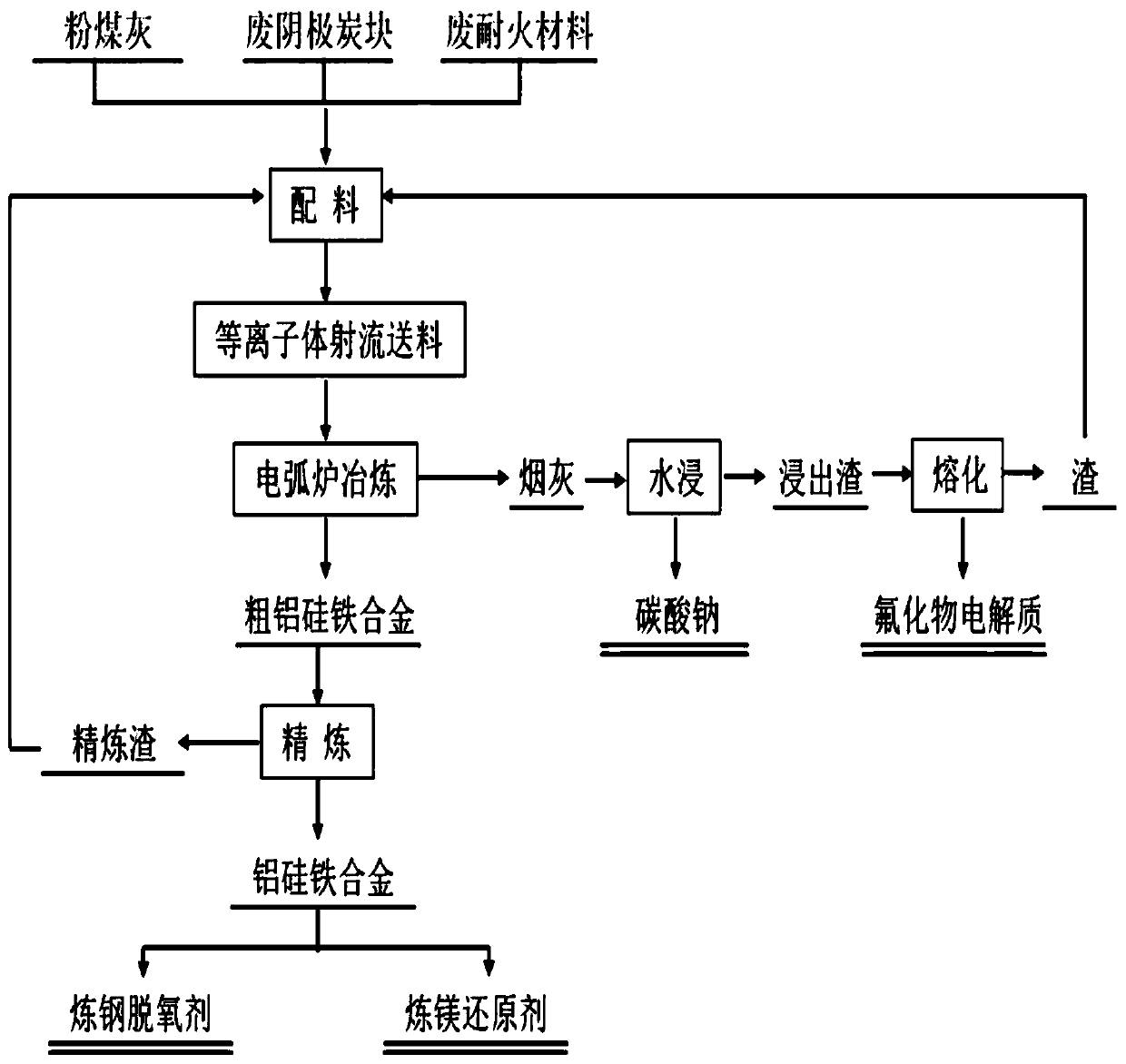Method for producing AlSiF from waste refractory material by plasma jet feeding
A waste refractory material and plasma technology, applied in the field of electrometallurgy, can solve the problems that resource utilization is still in the research stage
- Summary
- Abstract
- Description
- Claims
- Application Information
AI Technical Summary
Problems solved by technology
Method used
Image
Examples
Embodiment 1
[0041] The method for preparing Al-Si-Fe alloy by using waste refractory material as raw material by plasma jet feeding comprises the following steps:
[0042] Step 1, the waste refractory material, waste cathode carbon block and fly ash in the overhaul slag of the aluminum electrolytic cell are made into powder respectively, and the particle size is less than 100 mesh;
[0043] Step 2, according to the composition of the target aluminum silicon ferroalloy: aluminum content 25%, silicon content 65%, the rest is iron, calcium, titanium and other trace metals, using the fixed carbon contained in the waste cathode carbon block as the reducing agent according to the chemical The metering ratio is used to calculate the mass of waste refractory materials, waste cathode carbon blocks and fly ash required to reduce metal oxides, and finally the mass ratio of waste refractory materials, fly ash and waste cathode carbon blocks is 1:6:4. Put the waste refractory material, waste cathode c...
Embodiment 2
[0047] The method for preparing Al-Si-Fe alloy by using waste refractory material as raw material by plasma jet feeding comprises the following steps:
[0048] Step 1, the waste refractory material in the overhaul slag of the aluminum electrolytic cell, the waste cathode carbon block, the fly ash and the diatomite waste slag are respectively made into powders, and the particle size is less than 100 mesh;
[0049] Step 2, according to the composition of the target aluminum-silicon-ferroalloy: aluminum content 27%, silicon content 63%, and the rest are iron, calcium, titanium and other trace metals; the fixed carbon contained in the waste cathode carbon block is used as the reducing agent according to the chemical The metering ratio is used to calculate the mass of waste refractories, fly ash and spent cathode carbon blocks required to reduce metal oxides, and the mass ratio of waste refractory materials, fly ash to spent cathode carbon blocks is 1:3:2; Put the refractory materi...
Embodiment 3
[0053] The method for preparing Al-Si-Fe alloy by using waste refractory material as raw material by plasma jet feeding comprises the following steps:
[0054] Step 1, the waste refractory material, waste cathode carbon block and fly ash in the overhaul slag of the aluminum electrolytic cell are made into powder respectively, and the particle size is less than 100 mesh;
[0055] Step 2, according to the composition of the target aluminum silicon ferroalloy: the aluminum content is 31%, the silicon content is 58%, and the rest is iron, calcium, titanium and other trace metals; the fixed carbon contained in the waste cathode carbon block is used as the reducing agent according to the chemical The metering ratio is used to calculate the mass of waste refractories, fly ash, and spent cathode carbon blocks required to reduce metal oxides, and the mass ratio of waste refractory materials, fly ash to spent cathode carbon blocks is 1:1:1; Put the refractory material, waste cathode car...
PUM
| Property | Measurement | Unit |
|---|---|---|
| particle size | aaaaa | aaaaa |
| diameter | aaaaa | aaaaa |
| diameter | aaaaa | aaaaa |
Abstract
Description
Claims
Application Information
 Login to View More
Login to View More - R&D
- Intellectual Property
- Life Sciences
- Materials
- Tech Scout
- Unparalleled Data Quality
- Higher Quality Content
- 60% Fewer Hallucinations
Browse by: Latest US Patents, China's latest patents, Technical Efficacy Thesaurus, Application Domain, Technology Topic, Popular Technical Reports.
© 2025 PatSnap. All rights reserved.Legal|Privacy policy|Modern Slavery Act Transparency Statement|Sitemap|About US| Contact US: help@patsnap.com



